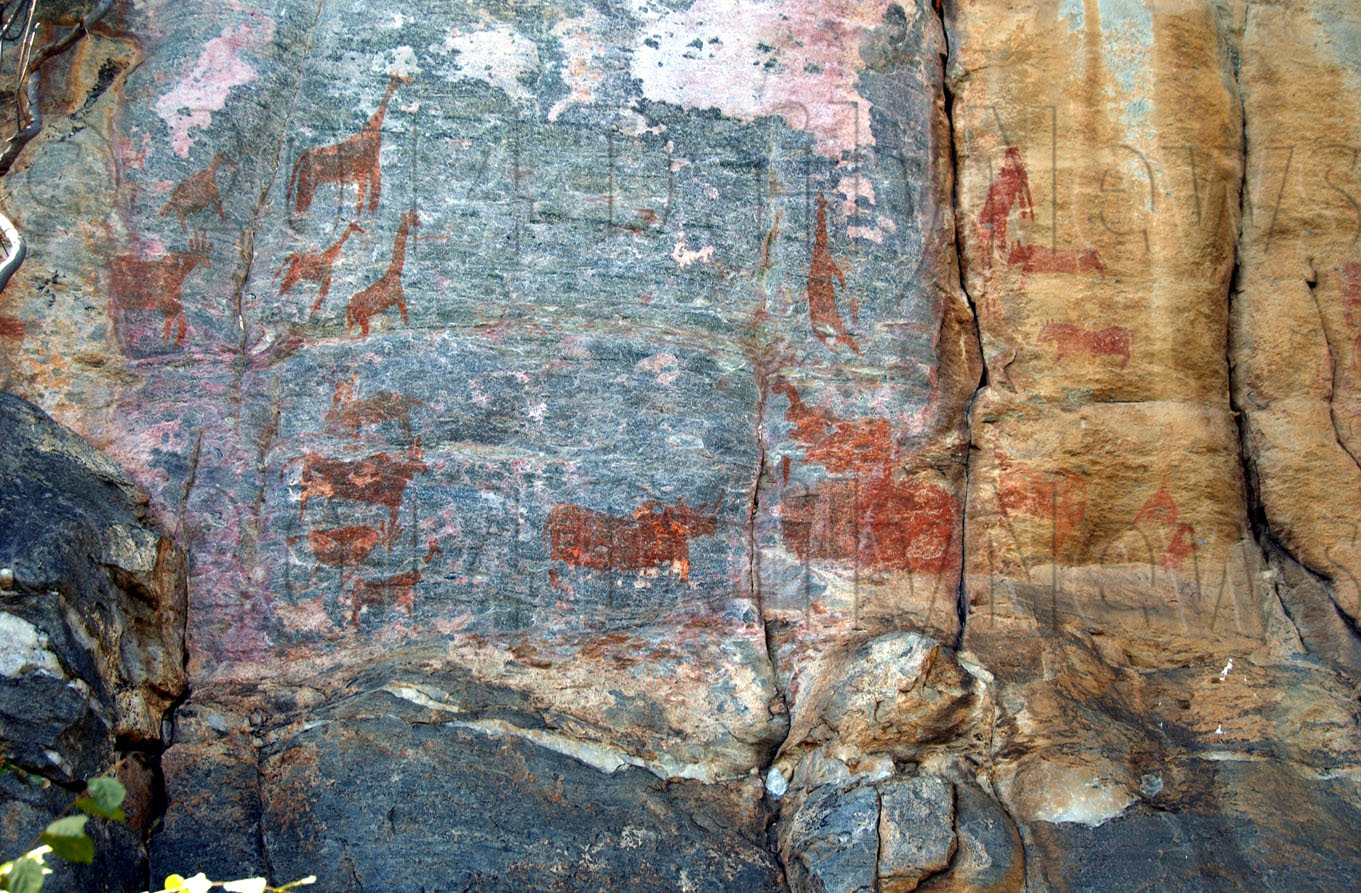Making sense of art of rock painting
29 Jul 2014
Rock painting is an art that was used by Basarwa as a form of communication and as a language. At that time, most Basarwa were not educated.
They deduced a form of communication readable within their own society. It is believed that they used animal blood that was mixed with some selected herbs. The mixture was not easily eroded by water or any other effect like aging or effects of global and environmental changes.
It is also important to note that this form of rock paintings were similar to the modern-day short message system (sms) used globally on cellular phones. Every drawing they left had, and still has, some significance to what it related to at that time.
As the paintings were a form of communication, they would reveal what the Basarwa first saw in their new settlement, for example, food, conflict, war, animals, their form of religion and other things.
These paintings would be of use in today’s global world of SMS if they were taken into use by the linguist to form a meaningful language. To date, the paintings are reduced to a mere tourist attraction with less value to its originator, who had no idea that they can go to the extent of patenting them as their intellectual property.
Basarwa used caves as their homes and drawing – it may even be argued -- that it was their form of entertainment and education.
It is believed that when they arrived at a cave, they painted to express their journey, feeling, religions, fears, problems encountered and other important things. The understanding is that the drawings of animals, to some extent, indicated that Basarwa found them in abundance on their arrival at a particular place.
A person running with a spear held above his head would indicate that there was conflict or war. Some of the paintings depict people dancing at the fire place, an indication of calmness, happiness, joy and at times an indication that the area was abundant in food supply hence they could manage to use energy in dancing.
When hunger and starvation became widespread, there would be some kind of paintings best interpreted by other Basarwa. This form of painting was language in itself that needed to be globally promoted and be incorporated in the curriculum.
Nobody knows the exact age of these paintings, some are believed to be more that 20 000 years old. The paintings are seen around the Tsodilo Hills in the North Western part of Botswana and other places in southern Africa.
The paintings were unique in that they always carried a similar message that any Mosarwa was able to interpret. The most worrying factor is that the rock paintings are not developing as a form of language or communication tool.
It would be a singular opportunity for Basarwa who did not go to school to be trained in their culture and be given certificates that would enable them to secure formal employment in the museums and art galleries and other government departments such as that of culture.
The rock paintings have now been transformed from an indigenous language to a tourist attraction.
There are no new developments or recent paintings of similar nature as those that were painted more than 350 years ago remained as souvenir for the posterity. The development of these paintings cannot defeat latter-day technology.
One may note that culture is universal and can be changed. While language is productive, it can be introduced in the new syllabi. Basarwa are still found in many parts of southern Africa, especially the Kgalagadi Desert and the Drakensburg. Therefore, research could be done to determine if the rock paintings could relate to letters of the alphabets.
When one looks broadly at the rock painting, they are still visible and can be revived.
The Chief Curator Archaeology at National Museum, Monuments and Arts Galleries, Mr Phillip Segadika, said in an interview that rock art already comes in as part of the social studies curriculum and archaeology for history students at the University of Botswana. However, he was not sure if there was need for a specialised incorporation in schools.
“Even though other people have convincingly argued that we need to consider aspects of modern graffiti to be a form of art, there are no new rock paintings,” he said.
He said rock art is a universal method of expression that is found in all parts of the world from the Americas to Europe, Asia and Africa.
Mr Segadika noted that rock paintings are not unique to Basarwa but were common to all indigenous people of the world.
“However, we should know that some of the rock paintings in all of Africa were authored by non San communities, an example is Malawi that has both Nyao (Bantu) paintings as well as what is known as Batwa (San) paintings,” he said.
In the same way, he said, some of the Tsodilo rock art, especially some white paintings, could well have been Bantu paintings as they were executed distinctly from the rest of the red paintings and reflected a more recent execution.
He however noted that there are no known Basarwa communities living today who can make sense of the intended message of the rock art besides the basic reading of the depicted objects such as animals.
On the other hand, archaeologists and rock art specialists who have studied some of the 19th and 20th century ethnographies of Basarwa in southern Africa discovered striking similarities between the belief systems of Basarwa and rock art.
Mr Segadika could not rule out the possibility of these rock paintings being a short message system or it being a full message system. He admits that anything is possible.
In professional rock art studies, there are two main schools of thought: one suggesting rock art as an expression of the natural environment; the other that sees rock art as spiritual.
In addition, Mr Segadika said some of the art work is either abstract or anthropogenic such as people with animal hoofs or animals with human heads, also the presence of some animals such as Eland is known to have evoked representations of potency.
He explains that rock art is found in two main forms of paintings and engravings, with the latter found in places such as Mamuno, along Botswana’s border with Namibia and at Matsieng, near Rasesa in Kgatleng.
“Altogether there are more than 300 rock art sites in Botswana, the most prolific is Tsodilo’s rock art which is a World Heritage Site,” he said.
As for paintings, Mr Segadika said they are found all over Botswana from Savuti in the Chobe to Thune and the rest of the Tuli area right through to Ntimbale and the rest of the North East, part of the Tswapong Hills and deep south at Manyana and snippets around Lobatse.
He said rock art is under threat from indigenous church groups who light fires at rock shelters during their healing and all night vigils at the hills. The resulting heat damages the rock.
He said public education, through radio programmes and kgotla meetings, was going on to sensitise the community on the importance of these rock paintings.
“We have also employed up to 70 custodians to take care of these and related sites throughout the country and we also undertake regular inspections to monitor natural factors which are also a major cause of degradation,” he said. ENDS
Source : BOPA
Author : Goweditswe Kome
Location : GABORONE
Event : Feature
Date : 29 Jul 2014






